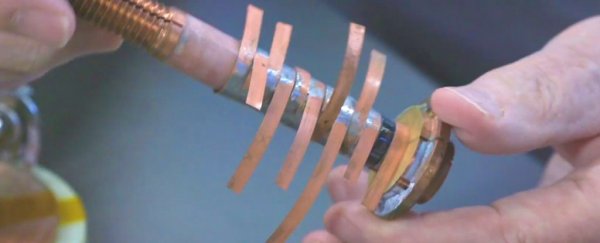A new superconducting magnet has briefly sustained an astonishing 45.5 tesla magnetic field intensity. For comparison, your flimsy fridge magnets have about 1 percent of a single tesla.
The measurement, achieved by researchers at the National High Magnetic Field Laboratory (MagLab) at Florida State University resets the bar on what's possible in direct current magnetic fields, exceeding the previous limit by half a tesla.
MagLab already houses the world's strongest continuous magnet, a hybrid that relies on pairing an insanely cold superconductor with a more typical electromagnet to operate.
Such chilly conditions require a small building's worth of pipes and machinery weighing some 35 tons. It goes without saying, this isn't a coin-sized chunk of metal you can use to pick up paperclips.
Truth be told, neither is their newer version, which also needs to be run at a temperature just a few degrees above absolute zero. But the core of the new system is still far more compact, a feature that's the secret to its success.
Small enough to fit inside a pint glass, it weighs a mere 390 grams (about 0.86 pounds) and looks a little like a short stack of flat discs wrapped in thin metal strips.
The strips are made from a metal called rare earth barium copper oxide (REBCO), replacing the niobium-based alloy used in its sibling 45T hybrid magnet.
Both the niobium-based alloy in the 45T and the 45.5T's REBCO strips can conduct an electrical current with virtually no resistance, helping them build strong magnetic fields.
One problem with conventional superconducting circuits is that when they heat up, they can suffer from a sudden jump in resistance called quench. Any flaw or deviation in their path causes conduction to become less than super, interrupting the flow.
The paper-thin strips of REBCO get around this by abandoning insulation, allowing the current running through any one section to quickly change lanes in the event of an interruption.
"The fact that the turns of the coil are not insulated from each other means that they can share current very easily and effectively in order to bypass any of these obstacles," says materials scientist David Larbalestier, who explains more about the magnet's design in the clip below.
Those tightly wound strips also dissipate heat that could interfere with the low resistance flow of electrons, allowing designers to ditch the usual copper heat sinks and further reduce bulk.
A tighter, more efficient superconductor helps this innovation squeeze out an even stronger magnetic field.
The 45T's superconductor could only crank out 11.4 tesla. When paired with a more garden variety 'resistive' electromagnet producing a field of 33.6 tesla, it reached its old record-setting limit.
Paired with a 31.1 tesla resistive magnet and dunked into a chamber of liquid helium, the most recent version of the team's REBCO-based 'little big coil' hit 14.4 tesla, adding up to a new record.
The old hybrid setup is still officially the strongest working magnet. This new version is only looking promising in trials so far.
Exactly how high we can go is still an open question. These limits are being busted every few years, with researchers thinking we could theoretically head into the triple digits based on what we currently know.
These kinds of magnets have applications in a diverse range of fields, from medical diagnostics to particle physics research.
"We are really opening a new door," says engineer Seungyong Hahn, who came up with the new magnet's slim design.
"This technology has a very good potential to entirely change the horizons of high-field applications because of its compact nature."
This research was published in Nature.
